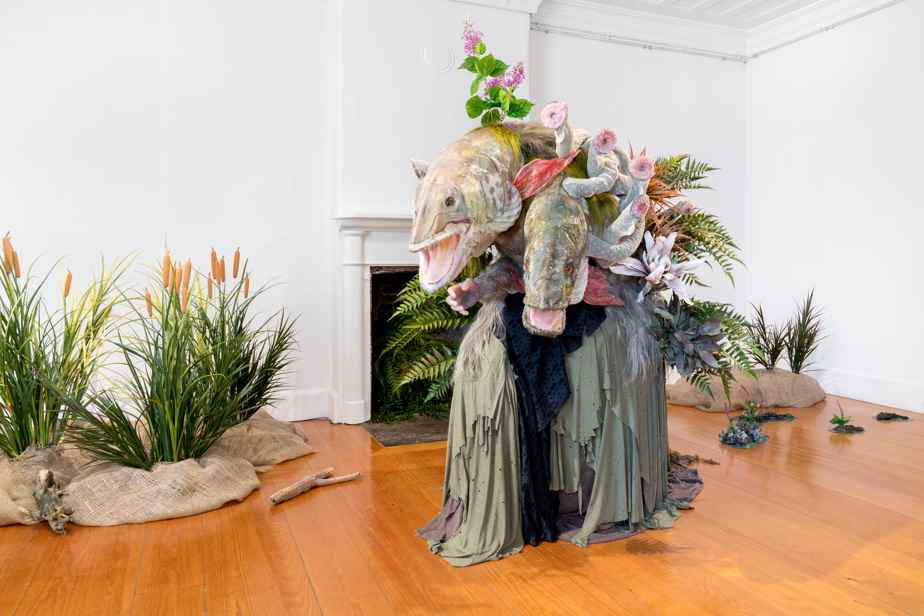(Trois-Rivières) Titled Walk, gait, maneuver, the 2022 edition of the National Biennial of Contemporary Sculpture (BNSC) presents in Trois-Rivières, Victoriaville and Montreal the works of 14 artists from Quebec, Canada and abroad who are well versed in space and the challenges of our time. With strong works that testify, for the most part, to concerns about the environment.
Posted yesterday at 6:00 a.m.
The majority of the artists invited to the BNSC this year spent between two and three weeks in Trois-Rivières to prepare their installations, which evoke the importance of walking, a banal but creative activity that brings out these new ideas in our heads. that change approaches and set things in motion. A theme that translates into an incredible diversity of expressions. With visual arts “at the crossroads of performance, video art, crafts and digital arts”, explains the curator of the event, Daniel Fiset.
This is the case of Cocoons, by Guillaume Brisson-Darveau, these organic sculptures in cellulosic pulp and dead insects. Body-sculptures on a human scale that the artist wears during performances and which evoke life, but also shelter.

PHOTO JEAN-MICHAEL SEMINARO, PROVIDED BY THE BNSC
Facility Cocoonsby Guillaume Brisson-Darveau, at the Galerie du Parc, in Trois-Rivières
Also at the Galerie du Parc, an impressive installation by Karen Tam, who took an interest in the Canadian author Winnifred Eaton, born in Montreal to British and Chinese parents in 1875, and known by the pen names Onoto Watanna and Winnifred Reeve. Karen Tam has recreated an Eaton family living space, with papier mache sculptures, tatami mats and textiles. A work made of plant plantations, with links to Chinese and indigenous communities, has also materialized in the backyard of the gallery.
The whole thing is an evocation of Asianness in America, but also of the discrimination long experienced by Chinese Americans and Chinese Canadians (about 1.5 million people in the country).
Another spectacular installation with Footprints-Kali Yuga I, by Emily Jan, an Edmonton-based artist from Los Angeles who deals with the consequences of our movements on Earth, namely the destruction related to the environmental emergency. She has created all kinds of plants and living organisms out of plastic, showing how far we have deviated from nature since the omnipresence of petroleum by-products in our daily lives rooted in the fake, with our fake plants, our fake wood coverings, our fake Christmas trees, etc.
-

PHOTO JEAN-MICHAEL SEMINARO, PROVIDED BY THE BNSC
Installation view Mrs. Spring Fragrance’s Morning Room and Gardenby Karen Tam
-

PHOTO JEAN-MICHAEL SEMINARO, PROVIDED BY THE BNSC
Corpus detail walking anthology (part 1 : embroider time), by Geneviève Baril
-

PHOTO JEAN-MICHAEL SEMINARO, PROVIDED BY THE BNSC
Corpus detail walking anthology (part 2 : I will be your mirror), by Geneviève Baril
-

PHOTO JEAN-MICHAEL SEMINARO, PROVIDED BY THE BNSC
Installation detail To meltby Patrick Beaulieu
-

PHOTO JEAN-MICHAEL SEMINARO, PROVIDED BY THE BNSC
Sculpture What we buildby Annie Charland Thibodeau, exhibited at Atelier Silex
-

PHOTO JEAN-MICHAEL SEMINARO, PROVIDED BY THE BNSC
Installation by Ursula Johnson titled Lukwaqn/Elukwet/Amalukwet/Nata’lukwet/Elukwek/Amalukwek/Nata’lukwek (To work/they work/they work for pleasure/they work innovatively/we work/we work for pleasure/we work innovatively). Exhibited at the Atelier Silex.
1/6
At the Center d’exposition Raymond-Lasnier, two installations by Geneviève Baril illustrate her walks on the shores of the St. Lawrence, which led her to create installations made of plants gathered from the wild. The two works ofwalking anthology testify to his sensitivity towards these plants that we begin to smell one after the other. In the adjoining room, we find with pleasure the corpus by snowmobile of Patrick Beaulieu, To meltwhich he pursued last winter to downtown Trois-Rivières!
The power of virtual reality
At Espace Pauline-Julien, New Yorker Sarah Rothberg raises awareness of the importance of the water cycle, its eternal march in our bodies and in nature. Our interactions with the vital liquid are illuminated through a virtual experience of a few minutes.
At the R3 art gallery (on the campus of the Université du Québec à Trois-Rivières), the duo formed by Edith Brunette and François Lemieux present a striking set of creations on the theme of our varied (and often spoiled) occupation. ) of the territory. With dried plants inserted in a kind of metallic capsule evoking nuclear energy. A reflection on habitat and our propensity to adopt attitudes that contradict the health of our common good, the little blue planet, of course.

PHOTO JEAN-MICHAEL SEMINARO, PROVIDED BY THE BNSC
Installation view go to, do with, pass the sameby Edith Brunette and François Lemieux
Note that this very intense biennial is also in Montreal, where CIRCA current art exhibits The Space Between Held Hands, by Canadian artist Charley Young, based in Halifax. The BNSC also presents The Unknown Future Rolls Towards Us, by Montrealer Adam Basanta, at the Center d’art Jacques-et-Michel-Auger, in Victoriavile, until September 3. A reflection on the Earth from where man would have disappeared completely. Like a walk in a gloomy future where the present would have only passed. A solid biennale, therefore, with works that put us before our responsibilities as citizens.

